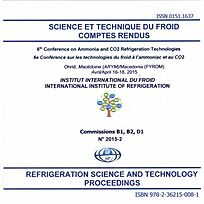
Document IIF
Energetic analysis of CO2/propane and CO2/propylene cascade refrigeration system.
Numéro : pap. n. 43
Auteurs : KAIROUANI L., JEMNI N., NEHDI E.
Résumé
Cascade systems using carbon dioxide, hydrocarbons and CO2/hydrocarbons mixture are studied. Theoretical models are written in FORTRAN. Thermodynamic parameters of fluids are given by REFPROP9.0 software. Working parameters (Te=-40C, Tc=40°C) are fixed. In the first step the most suitable hydrocarbons are selected. Three criteria have been fixed: Tcr, Tt and Tb. It is found that the hydrocarbons chosen in LPL are propane, propylene and ethane and those for the HPL are propane, propylene and isobutane. In the second step, xCO2 in the two loops has been varied and results are compared with cascade systems using CO2 and R22. Cascade system allows improved COP when pure fluids are used, except R22. It found also that for xCO2= 0.3 cascade system using propane/CO2 and propylene/CO2 mixtures presents a COP lower than that of cascade system using pure CO2. The higher COP is obtained when pure hydrocarbons are used in the two loops. COP=1.7, corresponds to propane (LPL)/isobutane (HPL) or propylene (LPL)/isobutane (HPL). An amelioration of the COP is observed when hydrocarbons are used in the HPL and CO2 in the LPL. COP=1.54, is reached when CO2 is used in LPL and isobutane is used in HPL. An improvement over the system using CO2 in the two loops, can reach 70%.
Documents disponibles
Format PDF
Pages : 8 p.
Disponible
Prix public
20 €
Prix membre*
15 €
* meilleur tarif applicable selon le type d'adhésion (voir le détail des avantages des adhésions individuelles et collectives)
Détails
- Titre original : Energetic analysis of CO2/propane and CO2/propylene cascade refrigeration system.
- Identifiant de la fiche : 30014669
- Langues : Anglais
- Source : 6th Conference on Ammonia and CO2 Refrigeration Technology. Proceedings: Ohrid, North Macedonia, April 16-18, 2015.
- Date d'édition : 16/04/2015
Liens
Voir d'autres communications du même compte rendu (53)
Voir le compte rendu de la conférence
Indexation
-
Thèmes :
Systèmes à compression;
CO2;
Hydrocarbures - Mots-clés : Propylène; R744; Propane; Système en cascade; Efficacité énergétique; Cycle transcritique; CO2
-
Análisis y evaluación experimental de un sistem...
- Auteurs : ANDREU-NACHER A., CABELLO R., VIDAN-FALOMIR F., LARRONDO-SANCHO R., LLOPIS R., SÁNCHEZ D.
- Date : 04/2022
- Langues : Espagnol
- Source : XI Congreso Ibérico y IX Congreso Iberoamericano de Ciencias y Técnicas del Frío, CYTEF 2022.
- Formats : PDF
Voir la fiche
-
Le CO2 : pression écologique ou réalité énergét...
- Auteurs : GUILPART J.
- Date : 10/10/2013
- Langues : Français
- Source : Pôle Cristal Symposium - 6th edition.
- Formats : PDF
Voir la fiche
-
Análisis experimental de las mezclas de refrige...
- Auteurs : LARRONDO-SANCHO R., FALOMIR F. V., SÁNCHEZ D., CABELLO R.
- Date : 26/06/2024
- Langues : Espagnol
- Source : 12th CYTEF Congress - Ibero-American Congress of Refrigeration Science and Technology.
- Formats : PDF
Voir la fiche
-
Optimization analysis on R290/CO2 cascade refri...
- Auteurs : LIU S., CHEN Y., NING J.
- Date : 16/08/2015
- Langues : Anglais
- Source : Proceedings of the 24th IIR International Congress of Refrigeration: Yokohama, Japan, August 16-22, 2015.
- Formats : PDF
Voir la fiche
-
Prediction and comparison of CO2 subcritical an...
- Auteurs : WANG N. H.
- Date : 26/08/2002
- Langues : Anglais
- Formats : PDF
Voir la fiche
